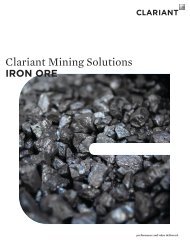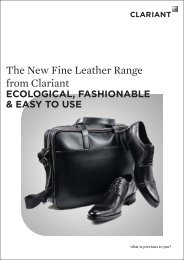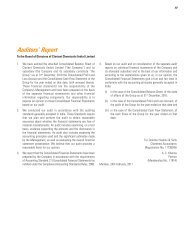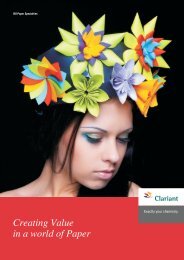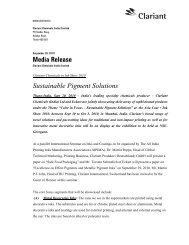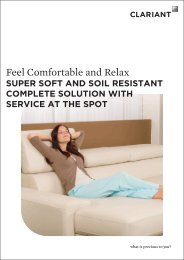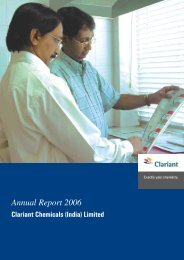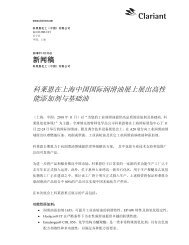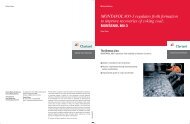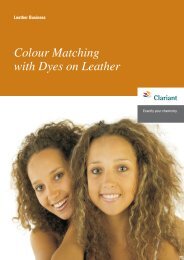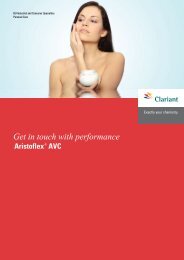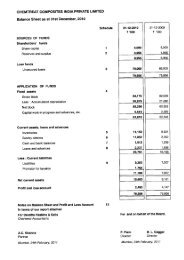You also want an ePaper? Increase the reach of your titles
YUMPU automatically turns print PDFs into web optimized ePapers that Google loves.
TLP Division<br />
Colour Chronicle<br />
A <strong>Clariant</strong> Chemicals (India) Limited Publication<br />
for the Textile, Leather, Paper & allied processing industries<br />
30 th year of publication<br />
Number 1 | 2009
<strong>colour</strong> <strong>chronicle</strong> 1 | 2009<br />
Contents<br />
q&a 3<br />
Inputs from the Industry on the Current Scenario<br />
textile 4<br />
Cationic Dyeable – PES Fibers<br />
PA and Cationic Dyeable – PES Fibers<br />
Dyeing on PES/PAN Fibers<br />
Pad-Batch with Drimaren<br />
Sulphur Black v/s Reactive Black<br />
Moisture Management<br />
leather 13<br />
<strong>Clariant</strong>´s Feel Additives<br />
paper 17<br />
Cartabond<br />
GOTS approved list 23<br />
new arrivals 23<br />
inside views 25<br />
gleanings from press 27<br />
2 <strong>colour</strong> <strong>chronicle</strong> 1 | 2009
Inputs from the Industry<br />
on the Current Scenario<br />
Do you think the Textile Industry today is facing a<br />
global recession?<br />
Yes defi nitely. Indian textile industry is facing the<br />
effects of global recession. Textile industry is not<br />
insulated from global recession because of shrinking<br />
of demand from US and Europe. Several new units<br />
have been set up in India in the past few years<br />
expecting the demand from US and Europe will<br />
continue to grow and now we are facing shrinkage<br />
in demand. Shrinking of liquidity is also responsible<br />
for shrinking of demand in textile.<br />
This shrinkage of demand is expected to continue for<br />
intermediate period since the supply and distribution<br />
pipeline is fl ush with stocks. Only after liquidation<br />
of this pipeline stock, is the demand expected to<br />
increase.<br />
How do you assess the threat from China?<br />
Indian rupee has depreciated in last six months where<br />
as Chinese currency has appreciated by nearly 8 to<br />
10%. India will be very much competitive in future.<br />
The deciding factors will be on time delivery and<br />
quality of the products. Costs are going up in China.<br />
In the last few months many production units have<br />
closed down or are running in reduced activity<br />
due to environment factors and power availability.<br />
We will be very much cost competitive but China<br />
will dominate the textile world as they have huge<br />
production capacities and can achieve quick<br />
turnaround of high volumes.<br />
What innovations do you plan with reference<br />
to branding, retailing, new products and new<br />
fi nishes?<br />
Raymond Zambaiti is a B2B business and our<br />
emphasis is on becoming a strong player in the<br />
industry. New product development is a continuous<br />
process. We have a development team which is<br />
working continuously on new products and new<br />
fi nishes.<br />
We are also working closely with our customers<br />
on their specifi c needs and new ideas. We have also<br />
expanded into Bottom Weights to better utilize our<br />
production capacity.<br />
How do you envisage the growth of brands and its<br />
impact on textile business?<br />
The growth of Brands has been phenomenal in the<br />
last ten years. Till 2007 most of the brands have<br />
grown by 20 to 40 % year after year. Number of<br />
brands have not increased much, but the existing<br />
brands have expanded. Capacities got built up in the<br />
past 5 to 6 years based on the projected domestic<br />
demand as well as growth in garment exports. In the<br />
current scenario, I personally believe the domestic<br />
brands will have a more “realistic growth” as<br />
compared to the highs of the previous years.<br />
What are your plans to expand your international<br />
textiles and retail business?<br />
Raymond Zambaiti is a Joint Venture between<br />
Raymond and Gruppo Zambaiti form Italy. About<br />
40% of our production is currently exported. Going<br />
forward considering the high cost of production in<br />
Italy compared to India, we expect our JV partners<br />
to source more fabrics from our unit in India.<br />
How do you see the role of dyes and chemical<br />
manufacturing companies (like <strong>Clariant</strong>) in future<br />
to help the textile industry?<br />
We have a lot of pressure on cost so we expect that<br />
chemical suppliers should come with innovative<br />
solutions / processes / products to make us cost<br />
competitive. Chemical suppliers should come<br />
out with speciality products, which offer better<br />
value for money in terms of perceivable benefi ts<br />
to the consumer. The challenge for the chemical<br />
companies is to come up with products and processes<br />
that are more sensitive to environmental issues as<br />
consumers become more and more environment<br />
conscious. Another challenge is to minimize energy<br />
consumption for which, the chemical suppliers have<br />
to come up with innovative solutions.<br />
Your message to the textile industry?<br />
It is going to be a tough time for the textile<br />
industry. In this period we have to focus on internal<br />
improvement in all areas and weather the period<br />
out. We will have to learn to work under a tight cost<br />
control regime but at the same time look at value<br />
addition at all levels.<br />
Mr. V. Vasudevan,<br />
Works Director,<br />
Raymond Zambaiti.<br />
q&a<br />
He has 30 years of industrial<br />
experience, with some of the<br />
leading companies in India<br />
like, Madura Coats Ltd.,<br />
Vardhman, India Polycot and<br />
Grasim Industries.<br />
<strong>colour</strong> <strong>chronicle</strong> 1 | 2009 3
4<br />
textile<br />
<strong>colour</strong> <strong>chronicle</strong> 1 | 2009<br />
Dyeing Methods and Dye Selection for Blends of:<br />
Cationic Dyeable – PES Fibers<br />
Cationic dyeable PES / CV is dyeable with same process<br />
as PAC / CV<br />
I – One Bath Method with Cationic/<br />
Indosol Dyes<br />
This method is only recommended for pastel and<br />
medium shades.<br />
Thiotan R paste prevents precipitation between<br />
the cationic dyes and anionic Indosol dyes, which<br />
may occur depending on the dyes and concentrations<br />
used.<br />
Standard Recipe<br />
It is essential to set the dye bath in the following<br />
order:<br />
Liquor ratio: 1/10<br />
a) 1 g/l Thiotan R paste<br />
0.5 g/l sodium acetate<br />
Run 5 – 10 min<br />
b) x % Cationic dye<br />
Run 5 – 10 min<br />
c) y % Indosol dye<br />
6 g/l sodium sulphate anhydrous<br />
d) Adjust pH to 4.5 – 5 with acetic acid.<br />
Dyeing Methods and Dye Selection for Blends of:<br />
PA and Cationic Dyeable – PES<br />
I. One bath method for pale to medium<br />
shade depths<br />
Dyeing Programme Dyebath Composition<br />
Temperature (°C)<br />
120<br />
110<br />
100<br />
90<br />
80<br />
70<br />
60<br />
50<br />
40<br />
0 50 100 150<br />
Time (min)<br />
Dyeing Programme<br />
Temperature (°C)<br />
120<br />
110<br />
100<br />
90<br />
80<br />
70<br />
60<br />
50<br />
40<br />
a - b - c - d<br />
30<br />
0 20 40 60 80<br />
Time (min)<br />
100 120 140 160<br />
II – One Bath Method with Foron RD/<br />
Indosol Dyes<br />
Same process as with PES normal but with 120°C<br />
fi xation temperature.<br />
For these two processes, the dyeing will be fi xed<br />
with Indosol E – 50.<br />
For pale shade we recommend Optifi x WEI liq.<br />
III – Two Bath Method with Cationic/<br />
Drimaren K or CL and HF Dyes<br />
For better brilliance and high wetfastness properties<br />
we can dye this blend with two baths – cationic<br />
dyes/cold reactive.<br />
1. Dyeing the PES anionic component with cationic<br />
dyes in the 1st bath.<br />
0.5 – 1 g/l Thiotan R paste<br />
6 g/l sodium sulphate<br />
0.5 g/l sodium acetate<br />
x % Cationic dye<br />
y % Nylosan dye<br />
pH 4.5 acetic acid 80%
Dyebath Composition<br />
x % Cationic dye<br />
0.5 – 1 g/l Thiotan R paste<br />
6 g/l sodium sulphate anhydrous<br />
0.5 g/l sodium acetate<br />
pH = 4.5 acetic acid 80%<br />
Dyeing Programme<br />
Temperature (°C)<br />
120<br />
110<br />
100<br />
90<br />
80<br />
70<br />
60<br />
50<br />
Fibers<br />
0 30 60 90 120<br />
Time (min)<br />
2. Overdyeing the viscose component with<br />
Drimaren dyes in the 2nd bath.<br />
Classic Drimaren dyeing with Thiotan R paste.<br />
II. One bath two stage method for<br />
medium to dark shade depths<br />
Dyeing Programme<br />
Temperature (°C)<br />
120<br />
110<br />
100<br />
90<br />
80<br />
70<br />
60<br />
50<br />
40<br />
Cationic Dye<br />
0 50 100 150<br />
Time (min)<br />
3. After treatment<br />
Rinse well<br />
Treat at 70 – 80°C for 15 min with,<br />
1 g/l Lyocol OI liq<br />
pH = 9 using soda ash<br />
Rinse.<br />
4. Special treatment for very high wetfastness<br />
properties.<br />
Aftertreat with Indosol E-50.<br />
Same Method in Reverse Order<br />
Although it is economical to carry out this method<br />
in the reverse order, i.e. fi rst dyeing the viscose<br />
component with Drimaren dye and then the PAC<br />
with cationic dye, the dyed viscose component is<br />
more heavily stained by the basic dyes while the<br />
PAC is being overdyed (mordant effect), than when<br />
dyeing according to the conventional method. For<br />
this reason the reverse method can only be carried<br />
out with especially selected basic dyes.<br />
In the interest of reliability and reproducibility<br />
we would not recommend this procedure.<br />
Dye Bath Composition<br />
1 g/l Thiotan R paste<br />
6 g/l sodium sulphate<br />
0.5 g/l sodium acetate<br />
x % Cationic dye<br />
y % Nylosan dye<br />
pH 4.5 acetic acid 80%<br />
Softening<br />
If softening is not carried out simultaneously in<br />
the dye liquor or brightening bath (this would be<br />
advantageous), the goods are treated in a separate<br />
bath with:<br />
0.7 – 1.5 % Ceranine PNL liquid<br />
At pH 5 – 6 for 15 min at 45°C<br />
textile<br />
<strong>colour</strong> <strong>chronicle</strong> 1 | 2009 5
6<br />
textile<br />
Alkali-scheme<br />
Fixation formula Suitable Drimaren<br />
Soda – formula K – HF<br />
NaOH + Silicate K – HF and CL<br />
NaOH + Soda K – HF and CL<br />
Soda formula<br />
Soda formula has long bath stability even<br />
at temperature upto 30 – 35°C.<br />
Are mostly used for heavy material due<br />
to long fi xation (better penetration).<br />
Give the impression of better<br />
levelness.<br />
Easy wash-off, no silicate.<br />
NaOH + Silicate<br />
NaOH + Silicate, in some cases, has even<br />
longer bath stability than soda-formula and<br />
are also stable at higher temperature of 30<br />
– 35°C.<br />
Fixation time around half of the sodaformula.<br />
The wash-off has to be very well<br />
monitored, beginning with cold water,<br />
to remove the silicate.<br />
<strong>colour</strong> <strong>chronicle</strong> 1 | 2009<br />
Dyeing on PES/PAN Fibers<br />
Dyeing on PES/PAN depends on the material<br />
but we can try to give you a general process<br />
for this blend on knit goods by exhaustion.<br />
There are three kinds of process.<br />
1. Two Bath Process with Carrier at 108°C<br />
This method is appropriate;<br />
if HT equipment is not available or if the<br />
dyebath cannot be brought to the boil,<br />
as a result there is no assurance of<br />
satisfactory shade buildup, particularly with<br />
dark shades such as black and navy.<br />
in the case of deep dyeings since the<br />
exhaustion of the cationic dye from the bath<br />
is retarded by the large amounts of carrier<br />
(retarding effect).<br />
Pre-dyeing the PES component has the advantage<br />
that the coloration of the PAC component by the<br />
Foron dye can be controlled.<br />
1st bath: Dyeing the PES component<br />
Dyebath additions<br />
2 – 6 ml/l Dilatin POE liquid<br />
2 g/l ammonium sulphate<br />
pH – 5 using formic acid<br />
CL and HF dyes requires less silicate<br />
than normal Vinyl Sulphone dyes and<br />
about half the amount of silicate.<br />
NaOH + Soda<br />
NaOH + Soda has shortest bath stability<br />
and highest exhaustion of the bath due to<br />
substantivity of the individual dyestuff.<br />
This alkali – formula is very sensitive<br />
to temperature. Should only be used<br />
at a constant temperature of around<br />
20 – 25°C.<br />
Fixation time is the shortest.<br />
Easy wash-off.<br />
Tailing<br />
Is caused by hydrolysis and difference<br />
in substantivity of the dyes.<br />
During hydrolysis the dye gets unstable<br />
and is reacting with the – OH group.<br />
Can only be controlled by alkali-scheme,<br />
temperature and time of the bath turnover.<br />
Substantivity is property of the selected<br />
dyes, individually.<br />
Dyeing Programme<br />
2nd bath: Dyeing the PAC component<br />
Dyebath additions.<br />
0.5 g/l sodium acetate<br />
pH 4.5 using acetic acid<br />
0.5 – 2% Retargal ANI liquid<br />
0.1 – 0.5 ml/l Ekaline FI liquid<br />
Dyeing programme<br />
Pad-Batch with Drimaren Parameters for Perfect Dyeing<br />
Dye selection.<br />
Alkali – formula.<br />
Temperature constant at 25°C (CDG<br />
has an advantage, dyestuff tank does not<br />
have to be cooled down and no urea).<br />
Dosing pumps; 1 : 4 alkali / dye. Most<br />
dye manufacturers have made their<br />
recipes after this dosing system.<br />
Pick-up 75 – 85 %, woven material,<br />
110 – 120 %, knitwear.<br />
Bath content 20-30 litre.<br />
From going into the dyebath until the<br />
padding mangle at no more than 1.5<br />
sec, else higher risk for exhaustion of<br />
the bath. Always use a wetting agent,<br />
like Hostapal UH. CN liq.<br />
The dye bath should only contain one<br />
roller at the bottom. With more rollers<br />
on top of each other, the pick-up cannot<br />
be controlled from side to side.<br />
Speed should not extend more than<br />
50 m/min.<br />
The batching temperature has to be<br />
constant at 30°C.
2. One-Bath Two-Stage Process at 108°C<br />
Intead of the two-bath process, the more economical<br />
one-bath two stage process, with pre-dyeing of the<br />
acrylic fi ber, can be adopted.<br />
With this method there is no unwelcome retarding<br />
effect by the carrier on the basic dye.<br />
Dyebath additions for PAC.<br />
0.5 g/l sodium acetate<br />
pH 4.5 acetic acid<br />
0.5 – 2 % Retargal ANI liquid<br />
0.1 – 0.5 ml/l Ekaline FI liquid<br />
X % Cationic dyes<br />
For PES.<br />
2 – 6 ml/l Dilatin POE liquid<br />
Y % Foron dyes<br />
Dyeing Programme<br />
Sulphur Black v/s Reactive Black<br />
Light Fastness<br />
Sulphur black rates 5 on the grey<br />
scale after 40 hours xenon.<br />
Reactive black rates only 3.0.<br />
Perspiration Light Fastness<br />
Test is based on duplicating exposure<br />
to light combined with perspiration.<br />
Sulphur black rates 5.0 after 20 hrs.<br />
Reactive black shows break at 2 hrs<br />
with a rating of 2.5 after 20 hrs.<br />
Dyeing Cycles<br />
Sulphur black can be dyed in<br />
3.5 – 4 hours vs typical reactive time<br />
of 6 – 7 hours.<br />
Sulphur cycles require much less<br />
salt (20 – 30 gm/l) vs reactive where<br />
100 – 120 gm/l is needed.<br />
Wash Fastness<br />
Sulphur black gives practicaly no stain<br />
in the AATCC 2a wash test. As a result<br />
of this, sulphur black can be used in<br />
“color blocking” with pastel shades.<br />
Reactive black would require a fi x<br />
to obtain the best results.<br />
3. One-Bath Process at 108°C<br />
Dyebath additions.<br />
1 – 2 ml/l Dilatin POE liquid<br />
0.3 – 1 ml/l Thiotan R paste<br />
0.5 g/l sodium acetate<br />
pH 4.5 acetic acid<br />
X % Cationic dyes<br />
Y % Foron dyes<br />
Dyeing Programme<br />
Crock fastness<br />
Wet crock fastness for shades of<br />
equal depth is about equal.<br />
Most reactive black shades are much<br />
lighter in depth, giving slightly better<br />
crock fastness.<br />
Reworks and overdyes<br />
Sulphur blacks are easily reworked<br />
using the original process without<br />
stripping.<br />
Reactive blacks require a caustic/<br />
hydro strip and full formula add.<br />
Sulphur black can be used to overdye<br />
many reactive colors without having<br />
to strip fi rst.<br />
Tendering<br />
Tendering is minimized by<br />
controlling the fabric pH.<br />
The fabric must have an alkaline<br />
pH from the dye machine prior to<br />
fi nishing.<br />
After fi nishing the pH must also be<br />
above 8.0.<br />
textile<br />
Lot Dyehouse Finished Original Aged %loss<br />
pH pH strength Strength<br />
1 9.5 8 89 80 10%<br />
2 9.8 7.4 90 81 10%<br />
3 9.3 8 87 85 2%<br />
4 9.8 8.1 97 94 3%<br />
5 8.3 102 87 14%<br />
6 8.4 104 95 9%<br />
7 8.5 107 96 10%<br />
8 9 107 93 13%<br />
9 7.4 106 87 18%<br />
Summary<br />
Good fastness in repetitive domestic<br />
washing.<br />
Excellent light and perspiration light<br />
fastness.<br />
Minimal water use and low salt use.<br />
Dyebath re-cycling is possible.<br />
A much deeper, richer shade of black.<br />
Easier re-processing and over-dyeing<br />
possibilities.<br />
Shorter cycles.<br />
<strong>colour</strong> <strong>chronicle</strong> 1 | 2009 7
textile<br />
8 <strong>colour</strong> <strong>chronicle</strong> 1 | 2009<br />
Moisture Management<br />
Complete removal of moisture combined with<br />
an accelerated spreading and evaporation rate<br />
results in a rapidly drying textile and thus increased<br />
wearing comfort with <strong>Clariant</strong>’s products :<br />
PA : Hydroperm RPU (best wash permanence)<br />
Hydroperm ECO (low to medium wash<br />
permanence)<br />
Cotton : Hydroperm RPU (best wash permanence)<br />
Hydroperm ECO (low to medium wash<br />
permanence)<br />
PES : Hydroperm SRHA (medium to high wash<br />
permanence)<br />
Remark: Hydoperm ECO is the best<br />
product for improving vertical wicking on CO and PA.<br />
Hydrophilic softener to be used with these<br />
products :<br />
Solusoft TOW Solusoft SE1<br />
Hydroperm HV Dilasoft TF<br />
Hydroperm RPU<br />
(a) Moisture management on PA and Cotton<br />
Moisture Management on polyamide with<br />
Hydroperm RPU<br />
Waterdrop absorbency<br />
300<br />
250<br />
200<br />
150<br />
100<br />
50<br />
0<br />
Hydroperm<br />
RPU<br />
Conventional<br />
hydrophilic finish<br />
Conventional<br />
finish<br />
Original 10 times washed at 40°C<br />
Absorbing time in seconds<br />
Vertical Wicking<br />
60<br />
50<br />
40<br />
30<br />
20<br />
10<br />
0<br />
Hydroperm<br />
RPU<br />
Conventional<br />
hydrophilic finish<br />
Conventional<br />
finish<br />
Original 10 times washed at 40°C<br />
Wicking height after 5 min.<br />
Washing conditions : ISO 6330 / 40°C gentle program<br />
tumble dried.<br />
b) Surface evaporation test (<strong>Clariant</strong> method)<br />
100<br />
90<br />
80<br />
70<br />
60<br />
50<br />
40<br />
30<br />
20<br />
10<br />
0<br />
Start 10 20 30 40 50<br />
Drying time in minutes<br />
100<br />
90<br />
80<br />
70<br />
60<br />
50<br />
40<br />
30<br />
20<br />
10<br />
Original finish<br />
Conventional<br />
hydrophilic finish<br />
10 times washed at 40°C<br />
Finished with<br />
Hydroperm RPU<br />
Testing conditions: 20°C, 65% air humidity<br />
Conventional finish<br />
Finished with<br />
Hydroperm RPU<br />
Testing conditions: 20°C, 65% air humidity<br />
Conventional finish<br />
Conventional<br />
hydrophilic finish<br />
0<br />
Start 10 20 30 40 50<br />
Drying time in minutes<br />
Washing conditions : ISO 6330 / 40°C gentle program<br />
tumble dried<br />
Wicking height in mm<br />
Residual moisture in %<br />
Residual moisture in %
Hydroperm ECO liq<br />
Hydrophilizing Agent for Moisture<br />
Management Finishes<br />
(a) Properties<br />
Weakly cationic.<br />
Chemical character : Aliphatic polyether amide<br />
solution.<br />
Improves perfectly wicking and surface<br />
evaporation properties.<br />
Supports the transport of moisture in an ideal<br />
manner.<br />
Causes no water drop marks.<br />
Imparts soft handle to the goods.<br />
Does not impair the degree of whiteness on<br />
optically brightened goods.<br />
First choice on cotton if wicking is the main<br />
point.<br />
Suitable for exhaust application on polyamide<br />
and PA-blends.<br />
For woven and knitwear.<br />
Not suitable together with resins and their<br />
catalysts.<br />
Not recommended for polyester and their<br />
blends.<br />
(b) Wicking height<br />
100 % cotton knitwear (Interlock)<br />
9<br />
8.5<br />
8<br />
7.5<br />
7<br />
6.5<br />
6<br />
Wicking height after 3 min according to M&S P136<br />
Original After 20x40°C launderings<br />
Unfinished 30 g/l Hydroperm ECO<br />
30 g/l Competitor<br />
product<br />
30 g/l Hydroperm ECO +<br />
15 g/l Solusoft TOW<br />
Washing conditions ISO 6330 / 40°C gentle program<br />
tumble dried.<br />
Wicking height in cm<br />
(c) Moisture management on PA and PA/Lycra:<br />
Example recipes:<br />
PA moisture management<br />
30 g/l Hydroperm ECO liq<br />
15 g/l Solusoft TOW liq c<br />
Pad and dry at 120-140°C.<br />
PA moisture management – best wash permanency<br />
30 – 40 g/l Hydroperm RPU liq<br />
15 g/l Solusoft TOW liq c<br />
Pad, dry and cure at 170°C for 15 sec.<br />
Permanent freshness and moisture transportation<br />
on PA and PA/Lycra<br />
40 g/l Hydroperm RPU liq<br />
10 g/l Solusoft TOW liq c<br />
13 g/l Sanitized T 27-22 Silver<br />
Pad, pick up 75 %, pH 5.5 with acetic acid.<br />
Dry and cure at 170°C for 15 sec.<br />
(d) Moisture Management on Cotton<br />
Guide recipes for cotton :<br />
Hydrophilic fi nish<br />
20 – 40 g/l Hydroperm ECO liq<br />
5 – 15 g/l Solusoft TOW liq c<br />
Pick up 70 %.<br />
Pad and dry at 120°C – 130°C.<br />
Hydrophilic Easy-Care fi nish<br />
40 – 60 g/l Arkofi x NES liq c<br />
10-15 g/l Catalyst NKC liq<br />
20 – 40 g/l Hydroperm RPU liq<br />
5 – 15 g/l Solusoft TOW liq c<br />
Pad, pick up 70 %.<br />
Dry and cure at 170°C for 20 sec.<br />
Permanent Freshness, Easy-Care and Moisture<br />
Transportation on Cotton<br />
50 g/l Arkofi x NES liq c<br />
13 g/l Catalyst NKC liq<br />
40 g/l Hydroperm RPU liq<br />
5 g/l Hydroperm HV liq<br />
10 g/l Solusoft TOW liq c<br />
8 – 10 g/l Sanitized T99 – 19<br />
Pad, pick up 75 %.<br />
Dry and cure at 170°C for 15 sec.<br />
textile<br />
<strong>colour</strong> <strong>chronicle</strong> 1 | 2009 9
10<br />
textile<br />
<strong>colour</strong> <strong>chronicle</strong> 1 | 2009<br />
Permanent Freshness and Moisture Transportation<br />
on Cotton<br />
30 g/l Hydroperm RPU liq<br />
10 g/l Solusoft TOW liq c<br />
4 – 5 g/l Sanitized T27-22 Silver<br />
Pad, pick up 75 %.<br />
Dry and cure at 160°C for 20 sec.<br />
effective curing temperature.<br />
(e) Hydroperm ECO liquid on Polyamide by<br />
Exhaustion<br />
Waterdrop Test on Polyamide<br />
Application condition :<br />
4 – 4.5 % Hydroperm ECO liq<br />
pH : 4.5 – 5.5 using acetic acid<br />
Temperature : 40°C<br />
Time : 20 min<br />
No rinsing, hydroextract and dry<br />
Hydroperm SRHA<br />
Soil Release / Hydrophilic / Antistatic<br />
a) Main features<br />
Hydroperm SRHA liq is a soil release and<br />
hydrophilizing agent for woven and knitted synthetic<br />
fi ber textiles, especially those made from polyester<br />
fi bers and polyester/cellulosic fi ber blends. This<br />
auxiliary overcomes the well known uncomfort of<br />
synthetic fi bers.<br />
b) Features<br />
Improves durable moisture absorbency of<br />
polyester fi bers.<br />
Imparts soil and stain release properties.<br />
Minimizes static build-up and adds comfort to<br />
the garments.<br />
Prevents soil re-deposition.<br />
Inhibits greying of polyester-containing fabrics<br />
during laundering.<br />
Saves time and money because it can be added<br />
directly to the dye-bath during high-temperature<br />
dyeing.<br />
Acts as a lubricant in the dyeing process,<br />
improving piece-to-piece consistency.<br />
c) Durable hydrophilic properties<br />
1. unfi nished (PES fi ber naturally hydrophobic).<br />
2. 5% (owf) Hydroperm SRHA liq.<br />
3. 5% (owf) Hydroperm SRHA liq / 1x 40 °C.<br />
4. 5% (owf) Hydroperm SRHA liq / 5x 40 °C.<br />
5. 5% (owf) Hydroperm SRHA liq / 10x 40 °C.<br />
After this Hydroperm SRHA treatment the<br />
uncomfortable PES is transformed into a hydrophilic,<br />
comfortable PES fi ber.<br />
d) Absorbency (Wicking test)<br />
Conventional PES fi nish<br />
Original 5 x 40°C wash 10 x 40°C wash<br />
Finished with 5 % (o.w.f.) Hydroperm SRHA liq<br />
Original 5 x 40°C wash 10 x 40°C wash
Antistatic behaviour according to Cling test<br />
5% Hydroperm<br />
SRHA liq unfi nished<br />
Soil release (dirty motor oil)<br />
Unfinished<br />
Original soiling with a after soiling, one<br />
drop of dirty motor oil additional wash<br />
5 x 40°C then soiling with after soiling, one<br />
a drop of dirty motor oil additional wash<br />
10 x 40°C then soiling with after soiling, one<br />
a drop of dirty motor oil additional wash<br />
Finished with 5 % (o.w.f.) Hydroperm SRHA liq<br />
Original soiling with a after soiling, one<br />
drop of dirty motor oil additional wash<br />
5 x 40°C then soiling with after soiling, one<br />
a drop of dirty motor oil additional wash<br />
10 x 40°C then soiling with after soiling, one<br />
a drop of dirty motor oil additional wash<br />
Stains are removed faster and easier during<br />
laundering.<br />
Application of Hydroperm SRHA liq<br />
The preferred method for applying Hydroperm<br />
SRHA is during high temperature dyeing in the<br />
disperse dye procedure. The product will exhaust<br />
onto the fabric like a dyestuff.<br />
4 – 7 % (o.w.f.) Hydroperm SRHA liq<br />
0.5 – 1 % (o.w.f.) Eganal PS liq<br />
1 g/l Opticid PB liq<br />
x % Disperse Dyestuff<br />
Example for pad application (wash durability is<br />
higher by exhaust application)<br />
15 – 25 g/l Hydroperm SRHA liq<br />
10 – 15 g/l Solusoft SE1 liq (20%)<br />
textile<br />
<strong>colour</strong> <strong>chronicle</strong> 1 | 2009 11
<strong>Clariant</strong>’s Feel Additives<br />
<strong>Clariant</strong>´s wide spread range of feel agents/<br />
additives hands out very versatile tools to the<br />
fi nishers and enables them to make customer´s<br />
wishes and dreams come true. But it’s not only<br />
the variety of feels alone, some of them are<br />
developed to improve selected properties too.<br />
Product Details<br />
In order to visualise the possibilities and<br />
characteristics of these products several tables and<br />
fi gures are given below. Besides the water based<br />
feel agents given here, some solvent based products<br />
are shown as well.<br />
Product SC Feel Comments<br />
Aqueous Feel Additives<br />
Melio Fettgriff SZ 25 dry, waxy very nice feel when added into dry mill, 1:100, the last 30 minutes of dry<br />
druming, slightly cationic, therefore check compatibility when used in mixes<br />
with anionic products, effective additive for cationic applications.<br />
Melio Fettgriff TRA 24 slightly dry, very close to Fettgriff SZ, more elegant effect, slightly cationic, therefore<br />
waxy check compatibility when used in mixes with anionic products.<br />
Melio Ground P 20 strong stoppy, for nappa types, gives a very natural feel, Do not overdose.<br />
waxy<br />
Melio Ground PS 20 stoppy, waxy- close to Ground P, more elegant, very useful for kind all kind of soft leathers<br />
greasy with a natural aspect and only thin finish films.<br />
Melio Wax 180 14,5 fatty/waxy soft wax, used as antisticking and feel improving agent in base coats, used<br />
also in aqueous top coats and feel applications.<br />
Melio WF – 5213.B 12 slightly dry, for all kind of leathers except white and automotive (yellowing), slightly<br />
waxy cationic, can be used as additive in cationic applications.<br />
Melio WF – 5220 36 warm-waxy special additive for automotive leathers, eliminates squeaking, can reduce<br />
soiling, feel also very attractive for all soft leathers, even with heavy layers.<br />
Melio WF – 5226 27,5 silky, slippery improves abrasion resistance and rubbings, counter type to HM-183.<br />
Melio WF – 5227 45 waxy increases abrasion resistance, not to be used with WF-5233 (can cause<br />
white spots), dries white, hence cannot be used as single product for<br />
oversprays.<br />
Melio WF – 5230 20 silky, greasy, very attractive feel for all kind of leathers, normaly not used for automotive<br />
natural (VOC), improves scratch resistance when used in patent leather imitation<br />
top coats, increases the gloss.<br />
Melio WF – 5238 50 silky, slippery succeeder of Melio WF-5226 conc., especially for automotive top coats,<br />
improves physicals especially when used as overspray.<br />
Melio WF – 5243 30 silky, creamy pleaseant creamy wet touch, for all nappa types.<br />
Melio WF – 5244 7 stoppy main use as hydrophobing agent, most effective when not used together<br />
with other (hydrophilic) products.<br />
Aqueous/Organic Feel Additives:<br />
Melio OF – 5215 14 oily, slippery for nappa types.<br />
Melio OF – 5216 57 slippery, can be used aqueous or organic, very nice for garment and nappa types,<br />
slightly waxy improves gloss.<br />
Organic Feel Additives:<br />
Melio Guard 5228.A 15 strong stoppy, very effective hydrophobing agent, feel can be modified with other organic<br />
Nubuck oils:<br />
dry dilutable feel agents.<br />
Melio Oil PO – 230 100 silky special feel oil for nubuck leathers, can be thinnend with Melio E – 700/710.<br />
Melio Oil PO – 232 100 strong grabby special feel oil for nubuck leathers, can be thinnend with Melio E – 700/710,<br />
for leathers with a very intensive feel.<br />
leather<br />
<strong>colour</strong> <strong>chronicle</strong> 1 | 2009 13
14<br />
leather<br />
<strong>colour</strong> <strong>chronicle</strong> 1 | 2009<br />
Product Categories<br />
Considering technical and promotional parameters we categorized our feel agents into the following groups:<br />
A – Categories: From Slippy to Stoppy<br />
Slippery Stoppy<br />
Slippery Sliding Silky/Velvet Waxy/Smooth Waxy/Stoppy Stoppy Specialities<br />
Melio OF – 5216 Melio WF – 5230 Melio WF – 5220 Melio Fettgriff SZ Melio Ground PS Melio Ground P Melio WF – 5244<br />
Melio WF – 5226 Melio WF – 5243 Melio Fettgriff TRA Melio Guard 5228.A<br />
Melio WF – 5238 Melio WF – 5213.B Melio Oil PO – 230<br />
Melio OF – 5215<br />
Melio Wax 180<br />
Melio WF – 5227<br />
Melio Oil PO – 232<br />
Some more details are shown in the table below. Please be aware of the fact that the perception of a feel and<br />
its description is very subjective. Never the less we would like to give you this table as a map to help you<br />
to fi nally reach your destination.<br />
B – Categories: Detailed Feel Descriptions<br />
dry waxy slippy oily greasy stoppy<br />
Melio Fettgriff SZ xx xxx 0 0 0 x<br />
Melio Fettgriff TRA x xxx 0 0 0 x<br />
Melio Ground P 0 xxx 0 0 0 xxx<br />
Melio Ground PS 0 xxx 0 x 0 xx<br />
Melio Wax 180 0 xxx x x x 0<br />
Melio WF-5213.B xx xx x 0 0 0<br />
Melio WF-5220 0 xx xxx xx 0 0<br />
Melio WF-5226 x 0 xxx 0 0 0<br />
Melio WF-5227 xx xxx 0 0 0 x<br />
Melio WF-5230 0 0 xxx xx xxx 0<br />
Melio WF-5238 x 0 xxx 0 0 0<br />
Melio WF-5243 0 x xxx xx x 0<br />
Melio OF-5215 0 x xxx xxx 0 0<br />
Melio OF-5216 0 xxx xxx xx 0 0<br />
C – Categories: Suitability by Leather Articles<br />
In another table we would like to show you the main fi elds of applications where the products can be used.<br />
Please be aware of the special characteristics developed to cover special requirements.<br />
Further details you have already seen in the short descriptions at the beginning.<br />
auto- shoe sport garment fancy uphol- special<br />
motive upper shoe goods stery characteristics<br />
Melio Fettgriff SZ x x x x<br />
Melio Fettgriff TRA x x x x<br />
Melio Ground P x x x x<br />
Melio Ground PS x x x x<br />
Melio Wax 180 x x x x<br />
Melio WF – 5213.B x x x x<br />
Melio WF – 5220 x x x x x anti-squeaking<br />
Melio WF – 5226 x x x x x<br />
Melio WF – 5227 x x x x x abrasion/taber resistance<br />
Melio WF – 5230 x x x x x<br />
Melio WF – 5238 x x x x x x abrasion/scuff resistance<br />
Melio WF – 5243 x x x x x<br />
Melio OF – 5215 x x x x x<br />
Melio OF – 5216 x x x x x x abrasion resistance
D – Categories: By Application<br />
Besides the usage with water/solvent as feel coat, the feel agents can be used in the following fi nishing<br />
systems (additionally light fastness and heat resistance are given):<br />
Protein Aqualen Melio Melio Light Fastness Heat Resistance<br />
top top EW-top N/ES-top 1:5 1:10 1:5 1:10<br />
Melio Fettgriff SZ (x) 5 5 – 4 6 5 – 4<br />
Melio Fettgriff TRA (x) 6 4 – 5 6 4 – 5<br />
Melio Ground P x x 5 – 6 4 – 5 6 4 – 5<br />
Melio Ground PS x x 6 4 – 5 6 5 – 4<br />
Melio Wax 180 (x) x x 5 4 – 5 5 – 6 4 – 5<br />
Melio WF – 5213.B (x) x x 6 4 – 5 6 5 – 4<br />
Melio WF – 5220 x x 6 – 5 5 – 4 6 4 – 5<br />
Melio WF – 5226 x x x 6 – 5 5 – 4 6 – 5 5 – 4<br />
Melio WF – 5227 x x 6 – 5 4 – 5 6 – 5 5 – 4<br />
Melio WF – 5230 x x x 5 – 6 4 – 5 6 – 5 5 – 4<br />
Melio WF – 5238 x x x 6 5 6 6 – 5<br />
Melio WF – 5243 (x) x x 5 – 6 4 5 4 – 5<br />
Melio OF – 5215 (x) x x 6 5 – 4 6 5 – 4<br />
Melio OF – 5216 (x) x x x 5 – 6 5 – 4 5 – 6 4 – 5<br />
Melio Guard 5228.A (x) x 6 6 6 – 5 6<br />
E – Categories: Specialities<br />
For Nubuck leathers two special feel promoters are available:<br />
dry waxy slippy oily greasy stoppy<br />
Melio Oil PO – 230 xxx xx xxx 0 0 0<br />
Melio Oil PO – 232 0 xxx 0 0 0 xxx<br />
Both oils may be used as single products or in combination with other oils/waxes to improve the feel.<br />
These two oils are not mixable with water.<br />
The hydrophobing agents into <strong>Clariant</strong>´s additive range are shown in the tables below, following the same<br />
discription order as shown for the feel additives above:<br />
Feel<br />
dry waxy slippy oily greasy stoppy<br />
Melio WF – 5244 xxx xxx 0 0 0 xxx<br />
Melio Guard 5228.A xxx x 0 0 0 xxx<br />
Main Application<br />
auto- shoe sport garment fancy uphol- special<br />
motive upper shoe goods stery characteristics<br />
Melio WF – 5244 x x x x x hydrophobing<br />
Melio Guard 5228.A x x x x x hydrophobing<br />
Main Use in following Systems:<br />
Protein Aqualen Melio Melio Light Fastness Heat Resistance<br />
top top EW-top N/ES-top 1:5 1:10 1:5 1:10<br />
Melio WF – 5244 x x 6 – 5 4 – 5 6 4 – 5<br />
Melio Guard 5228.A x x 6 – 5 5 – 4 6 – 5 5 – 4<br />
leather<br />
<strong>colour</strong> <strong>chronicle</strong> 1 | 2009 15
Cartabond<br />
Why insolubilizers are useful for improving the runnability and print<br />
quality of coated / uncoated paper on offset press<br />
Reasons of Offset Printing Defects<br />
– Easily released or free<br />
fibers, filler, coating pigment<br />
particles<br />
– Dust from previous handling<br />
(production, cutting)<br />
– Wetting by fountain water<br />
– Ink tackiness<br />
– Pulling forces / printing nip<br />
Offset Printing and Wet Picking<br />
Water is adsorbed on the hydrophilic areas of the<br />
printing plate and ink on the hydrophobic ones.<br />
Ink and water are transferred from the printing<br />
plate to the blanket and from the blanket to the<br />
paper. The paper goes through several presses to<br />
be printed by each color before drying.<br />
Picking occurs when the ink fi lm is split between<br />
the paper and the rubber blanket if the paper is<br />
weakened by water addition on the previous<br />
presses.<br />
Printing nip<br />
Next Press<br />
Picking area<br />
Fountain Water<br />
Offset Printing<br />
defects<br />
Offset blanket<br />
piling<br />
Offset press<br />
productivity<br />
Printing Ink<br />
Printing<br />
Plate<br />
Rubber<br />
Blanket<br />
Paper<br />
Printing Defects Related to the Paper<br />
Surface Strength<br />
Printing Printing Influenced Uncoated<br />
defect process by surface or coated<br />
strength paper<br />
Picking Offset, Dry / wet uncoated<br />
letterpress<br />
Coating Offset, Dry / wet coated<br />
pick letterpress<br />
Wet pick Offset Wet coated<br />
(multi<strong>colour</strong><br />
press)<br />
Piling Offset Wet coated /<br />
(blanket) uncoated<br />
Milking Offset Wet coated /<br />
uncoated<br />
Dry pick Letterpress Dry Coated /<br />
(flexo, gravure uncoated<br />
Blister Offset, Dry / wet Coated<br />
pick letterpress<br />
Dusting Offset, Dry / wet uncoated<br />
letterpress<br />
Linting Offset Wet uncoated<br />
Fiberpick Offset Wet uncoated<br />
Relationship between Particles and Fibers Buildup<br />
on Blankets vs Offset Print Quality<br />
Print quality : 1 : good - 5 : bad<br />
paper<br />
<strong>colour</strong> <strong>chronicle</strong> 1 | 2009 17
paper<br />
18 <strong>colour</strong> <strong>chronicle</strong> 1 | 2009<br />
Relationship between Particles and Fibers Buildup<br />
On Blankets vs Wet Rub Resistance<br />
Relationship between Particles and Fibers Builtup<br />
on Blankets vs IGT Dry Pick<br />
Four Good Reasons for using an<br />
Insolubilizer in Coating Recipes<br />
1) A Clear Correlation Exists between the Wet<br />
Surface Strength (WSS) of Paper And their<br />
Offset Printing Runnability :<br />
Offset printing defects, such as blanket piling,<br />
wet picking of coated paper, as well as dusting,<br />
can be signifi cantly reduced or avoided when the<br />
paper’s WSS is increased.<br />
The best correlation is obtained between offset<br />
runnability / printing defects and WSS, as<br />
measured through Adams wet rub or modifi ed<br />
Taber abrasion tests. Other characteristics, like<br />
dry surface strength (dry IGT or Prüfbau) are not<br />
so well linked to the behaviour of the paper in<br />
offset printing.<br />
The productivity and the quality of the offset<br />
printing process directly depends on WSS – this<br />
can be expressed by the number of printed copies<br />
before cleaning the offset press.<br />
2) WSS is a Varying, Hardly Controllable Property<br />
of Printing Paper :<br />
Once the paper has left the drying section, its<br />
WSS naturally increases by itself but very slowly,<br />
and reaches a maximum after one to two months<br />
of storage. This is due to the constant evolution<br />
of cellulosic fi bers, starch, and particularly<br />
synthetic binders for coated papers, with time.<br />
This phenomenon is strongly dependent on the<br />
storage temperature. For this reason, papers<br />
stored in winter or summer may have very<br />
different printabilities.<br />
The quality and variability of the raw materials<br />
used in the paper production also increases the<br />
variability of the WSS.<br />
3) Offset Printers can be unsatisfied with,<br />
irregular, insufficient and unpredictable Offset<br />
Printabilities :<br />
Offset printers are very concerned by the defects<br />
they observe on the papers they have printed.<br />
This affects the quality and consequently the<br />
value of their work.<br />
Offset printers are not interested to spend time<br />
and money for cleaning the offset blanket,<br />
because deposits have been collected from the<br />
paper, and degrade the printing quality.<br />
If such problems occur, they may have two kinds<br />
of attitude :<br />
– Either they can claim to the paper producer<br />
and ask for money as a compensation of<br />
the loss of productivity and paper quality.<br />
They may give a chance to their supplier for<br />
improving the paper quality.<br />
– Or they may directly prefer to switch to<br />
another supplier, providing similar paper,<br />
but with better-offset runnability. In such<br />
cases, papermakers are merely losing some<br />
of their customers.<br />
4) The regular use of an Efficient Insolubilizer is the<br />
Right Way to Ensure a Constant and Satisfactory<br />
Offset Printability<br />
There are many ways to improve the WSS,<br />
through the choice of the fi ber composition<br />
or refi ning degree, optimization of the sheet<br />
formation, optimized choice of surface starch,<br />
synthetic binders, etc., but the more direct,<br />
economical and controllable way to achieve high<br />
levels of WSS is to use an effi cient crosslinker.<br />
Its role is to reduce the water sensitivity of the<br />
polymers (starch, PVOH, synthetic binders, etc.)<br />
and cellulosic fi bers located close to the surface,<br />
by a crosslinking action.
A fast reacting insolubilizer provides high and<br />
controllable levels of WSS just at the end of the<br />
drying section.<br />
The use of an effi cient crosslinker gives the<br />
insurance to maintain a regular paper quality, in<br />
terms of offset printability, against the negative and<br />
unpredictable impacts of process, raw materials or<br />
storage time and temperature variations.<br />
Not using any insolubilizer, can result in<br />
apparent cost savings like driving a car without<br />
insurance! but fi nally with the risk of expensive<br />
consequences.<br />
The use of a good insolubilizer is the right way<br />
to :<br />
– Save money, as the probability of claims<br />
from offset printers can be signifi cantly<br />
reduced, even to zero.<br />
– Secure market shares, keeping offset<br />
printers as satisfi ed, regular and loyal<br />
customers.<br />
As a performaner insolubilizer, <strong>Clariant</strong><br />
recommends the regular use of Cartabond EPI<br />
liquid, an effi cient and fast reacting crosslinker,<br />
that papermakers often need to ensure the right<br />
and constant level of offset printability for their<br />
papers.<br />
Cartabond EPI liquid is a recognized tool for<br />
improving the WSS of uncoated and coated<br />
offset paper in 18 countries in the world.<br />
Characterization of the Paper Wet<br />
Surface Strength<br />
Surface wet abrasion test : Evaluation of paper<br />
surface strength in wet conditions using a modifi ed<br />
Taber abrasion equipment - comparative test<br />
Offset printability defects (blanket piling, linting,<br />
milking, picking etc., can be well correlated with<br />
the measurement of the paper wet surface strength.<br />
The best way to improve the paper wet surface<br />
strength is to crosslink the hydrophilic binders and<br />
cellulosic fi bers with a Surface Strength Improver<br />
Crosslinking action of Cartabond EPI on hydroxyl<br />
groups from starch, CMC, PVOH, cellulose<br />
Cartabond EPI liquid<br />
Highlights<br />
Effi cient Surface Strength Improver.<br />
Crosslinks hydrophilic binders,<br />
such as starch, PVOH, proteins.<br />
Mainly used in size press application, also in<br />
coating.<br />
Reduces dusting, wet picking, piling, etc.<br />
Improves offset printability.<br />
Formaldehyde free.<br />
Fast curing.<br />
Easy repulping.<br />
Typical dosage : 1 to 8 % dry on dry binder.<br />
Complies with FDA 176.180 and BGVV XXXVI<br />
requirements.<br />
paper<br />
<strong>colour</strong> <strong>chronicle</strong> 1 | 2009<br />
19
20<br />
paper<br />
<strong>colour</strong> <strong>chronicle</strong> 1 | 2009<br />
Action mechanism<br />
DRY<br />
WET<br />
DRY<br />
WET<br />
Starch<br />
Fibres<br />
Uncrosslinked<br />
Crosslinked<br />
Filler particles<br />
Crosslinker<br />
Influence of Crosslinker on WSS and Offset Press<br />
Productivity<br />
Production : 6 tons / hr - deinked pulp - 80 gsm<br />
Size Press : native starch 3 gsm + OBA<br />
Printing issues : dry pick on large black areas - deposits<br />
on blanket (piling)<br />
Number of Printed Copies before Blanket Cleaning<br />
Case history : Cartabond TSI for MWC -<br />
Roll Offset - Magazine paper<br />
Production : Coated offset printing paper for<br />
magazines - 110000 tons / y.<br />
Grammage : 70 to 180 gsm – wood containing<br />
pulp.<br />
Coating <strong>colour</strong> : (dry parts)<br />
Clay: 25<br />
Calcium Carbonate: 75<br />
Synthetic latex: 10<br />
CMC: 0.3<br />
PVOH: 0.3<br />
Leucophor NS : 0.75<br />
pH: 8.5 - Dry content : 63 %<br />
Coated weight : 10 gsm / side – top coat<br />
Case history : Cartabond TSI for MWC –<br />
Roll offset – Magazine paper<br />
IGT wet pick (3804 ink): Quotation:<br />
UF res.: 3 Cartabond TSI : 1 (good).<br />
Whiteness : same for both products : WCIE : 112<br />
- R457 : 88.<br />
Offset printing : OK.<br />
Cartabond TSI has replaced the UF resin (0.3 pt<br />
against 1.6 UF).
Summary<br />
Coating Binder Cartabond Cartabond<br />
process composition TSI / EPI MZI / KZI<br />
Size – Press Starch XXX 0<br />
Pigmented, Starch XXX 0<br />
pre-metering Synthetic<br />
Size – Press Latex<br />
Starch XXX X<br />
Single<br />
coating<br />
Synthetic<br />
Latex<br />
Pre – coating CMC<br />
Synthetic<br />
latex<br />
XX XX<br />
To – coating<br />
Summary<br />
Starch XX XX<br />
Synthetic<br />
Latex<br />
CMC 0 XXX<br />
Synthetic<br />
latex<br />
Conclusion<br />
Like an insurance, the use of insolubilizers in<br />
coating recipes is often necessary to reduce the<br />
risk of non-conformity in terms of offset printing<br />
quality and offset press machinability.<br />
<strong>Clariant</strong> has 15 years technical experience in<br />
the use of crosslinkers for improving the paper<br />
wet surface strength and consequently the offset<br />
printing performances.<br />
Taylored made laboratory evaluations can be<br />
implemented in order to establish a diagnostic<br />
on the paper wet surface strength and eventually<br />
recommend the right insolubilizer with preferred<br />
addition levels.<br />
<strong>Clariant</strong> proposes a full range of insolubilizers<br />
from 3 different chemical families, which can<br />
cover most of the needs of the paper industry.<br />
paper<br />
Product Chemistry Patented Food contact Application Benefits<br />
technology compliance<br />
Cartabond TSI High – reactivity YES BfR 36 FDA 176.180 Uncoated and coated Multipurpose<br />
Glyoxal – based crosslinker offset printing paper, surface strength<br />
office paper, silicon- improver<br />
release, carbonless Resistance to high<br />
paper temperature and pH<br />
conditions in coating<br />
<strong>colour</strong> (resp. up to<br />
70°C and 9.5)<br />
Cartabond EPI High – reactivity Glyoxal- YES BfR 36 Uncoated and coated Multipurpose<br />
based crosslinker FDA 176.180 offset printing paper, surface strength<br />
FDA 176.170 office paper, silicon- improver<br />
release, carbonless Optimized costpaper<br />
performance<br />
Cartabond MZI High – reactivity YES BfR 36 Coated offset printing Activated zirconium<br />
Ammonium Zirconium – FDA 176.180 paper (LWC, MWC) technology allows<br />
based crosslinker FDA 176.170 higher cost<br />
performance vs<br />
benchmark<br />
Cartabond KZI Starch YES BfR 36 Coated offset printing Activated zirconium<br />
Synthetic Latex FDA 176.180 paper (LWC, MWC) technology allows<br />
FDA 176.170 higher cost<br />
performance vs<br />
benchmark<br />
No ammonia smell<br />
<strong>colour</strong> <strong>chronicle</strong> 1 | 2009 21
Result of Assessment of Dye / Processing aid<br />
for the use in EKO Sustainable Textile Standard<br />
(GOTS system)<br />
Name dye/Proc. aid Date of Approved<br />
approval Yes / No<br />
Ceranine SWPI liq 25/06/2007 Yes<br />
Diresul Antioxidant PRM liq 25/06/2007 Yes<br />
Drimaren Turquoise CL-B p 13/03/2007 Yes<br />
Sirrix 2 UD.IN liq 13/08/2007 Yes<br />
Drimaren Navy X-GN.IN 06/09/2007 Yes<br />
Drimaren Red X-6 BN p 06/09/2007 Yes<br />
Drimaren Yellow X-4RNI p 06/09/2007 Yes<br />
Leonil UH liq 06/09/2007 Yes<br />
Sirrix Antox.IN liq 06/09/2007 Yes<br />
Imacol C2G.IN liq 12/10/2007 Yes<br />
Sirrix N liq c 12/10/2007 Yes<br />
Ceraperm K.IN liq 12/10/2007 Yes<br />
Stabilizer AWN.IN liq 12/10/2007 Yes<br />
Stabilizer FCB.IN liq c 12/10/2007 Yes<br />
Sirrix SB.IN liq 12/10/2007 Yes<br />
Appretan ECO liq 12/10/2007 Yes<br />
Imerol XN.IN liq 04/08/2007 Yes<br />
Printofix Thickener CA liq 13/11/2007 Yes<br />
Revatol S.IN p 13/11/2007 Yes<br />
Sirrix N liq 13/11/2007 Yes<br />
Stabilizer SIFAM.IN liq 13/11/2007 Yes<br />
Printofix Binder 1912 PLUS 14/12/2007 Yes<br />
Printofix Binder ITL liq 14/12/2007 Yes<br />
Hostapal DTC.IN liq<br />
Formerly (Sandopan<br />
DTC.IN liq)<br />
22/01/2008 Yes<br />
Imerol NLF.IN liq (Formerly,<br />
Sandoclean NLF.IN liq)<br />
22/01/2008 Yes<br />
Leomin PNLI liq (Formerly,<br />
Sandosoft PNLI liq)<br />
22/01/2008 Yes<br />
Ceralube JNF.IN liq<br />
(Formerly, Sandolube<br />
JNF.IN liq)<br />
22/01/2008 Yes<br />
Ceralube HD.IN liq<br />
(Formerly, Sandolube<br />
HD.IN liq)<br />
22/01/2008 Yes<br />
Imerol MWP liq c (Formerly,<br />
Sandoclean MWP liq c)<br />
22/01/2008 Yes<br />
Ladipur SN liq (Formerly,<br />
Sandopur SN liq)<br />
22/01/2008 Yes<br />
GOTS approved list new arrivals<br />
Name dye/Proc. aid Date of Approved<br />
approval Yes / No<br />
Optisul HSI liq<br />
(Formerly, Sandozol HSI liq)<br />
22/01/2008 Yes<br />
Stabilizer SIFA.IN lq 11/02/2008 Yes<br />
Imerol SR liq 11/02/2008 Yes<br />
Stabilizer SOF.IN liq 11/02/2008 Yes<br />
Diresul Black RDT-S-IN liq<br />
(Formerly, Diresul Black<br />
RDT liq)<br />
11/02/2008 Yes<br />
Drimaren Blue HF-2B cdg 12/02/2008 Yes<br />
Ladipur R3C.IN ip liq 12/02/2008 Yes<br />
Drimaren Navy CL-R p 12/02/2008 Yes<br />
Arkofil PVS p 13/03/2008 Yes<br />
Arkofil S 100 p 13/03/2008 Yes<br />
Ceraperm 3P PLUS liq 13/03/2008 Yes<br />
Ceraperm AQUA liq 13/03/2008 Yes<br />
Drimaren Red CL BL 13/03/2008 Yes<br />
Drimaren Red CL-B p 13/03/2008 Yes<br />
Drimaren Yellow CL-R p 13/03/2008 Yes<br />
Ladiquest DWA liq 13/03/2008 Yes<br />
Leomin SFC liq 13/03/2008 Yes<br />
Printofix Navy R-B 13/03/2008 Yes<br />
Printofix Violet R-B 13/03/2008 Yes<br />
Printofix Black R-NG liq 13/11/2007 Yes<br />
Printofix Blue R-BN 20/03/2007 Yes<br />
Ceraperm TSLF liq 11/06/2008 Yes<br />
Ceraperm 3P liq hc 11/06/2008 Yes<br />
Reductor D.IN p 11/06/2008 Yes<br />
Stabilizer 3Z liq 11/06/2008 Yes<br />
Sirrix SAI liq c 12/06/3008 Yes<br />
Hostalux ETB.IN liq 17/06/2008 Yes<br />
Leucophor BMF.IN liq 17/06/2008 Yes<br />
Leucophor BMB.IN liq 17/06/2008 Yes<br />
Leucophor BFB.IN liq 17/06/2008 Yes<br />
Appretan PUL liq 29/07/2008 Yes<br />
Ceraperm MN liq 29/07/2008 Yes<br />
Mercerol QWNI.IN liq 29/07/2008 Yes<br />
Mercerol RWLF liq 29/07/2008 Yes<br />
Sirrix CPA liq 29//07/2008 Yes<br />
Sirrix USB liq 29/07/2008 Yes<br />
Global<br />
Launch<br />
Nylosan S ®<br />
In addition to the existing ternary<br />
combination (for nylon) of:<br />
Nylosan Yellow S – L sgr<br />
Nylosan Red S – B p<br />
Nylosan Blue S – R p<br />
The new additions are:<br />
Nylosan ® Orange S – 3R sgr<br />
Nylosan Red S – 3B sgr<br />
Nylosan Navy S – 3G sgr<br />
All three new dyestuffs are valuable<br />
additions to the existing Nylosan S range<br />
and represent a true new ‘State of the<br />
Art’ as regards wet fastness for the Super<br />
Milling Dyestuff class.<br />
Features and benefits:<br />
Exceptionally high wet – fastness.<br />
High degree of combinability with no<br />
blocking effect.<br />
Very high build up – particularly on<br />
nylon micro-fi ber.<br />
Moderate PU stain in PA/PU blends.<br />
Simple, conventional application on<br />
both nylon and wool.<br />
Suitable for wool fi bers with excellent<br />
coverage.<br />
Minimal wool fi ber damage dyeing in<br />
the iso-electric region – pH 4.5.<br />
Very high fastness on wool to ‘in house’<br />
processing.<br />
Metal Free.<br />
<strong>colour</strong> <strong>chronicle</strong> 1 | 2009 23
24<br />
new arrivals<br />
<strong>colour</strong> <strong>chronicle</strong> 1 | 2009<br />
Additions in Local Range<br />
Foron Scarlet S-WF<br />
High wet fast disperse dye for red and scarlet shades<br />
suitable for dyeing polyester and its blends.<br />
High wet fastness. Low staining on multifi ber<br />
even on post heat set fabric.<br />
Can be applied in exhaust, printing and<br />
continuous application.<br />
Main element for wet fast fi re shade in<br />
combination with Foron Brilliant Yellow S–WF,<br />
Foron Golden Yellow S–WF, and Foron Red<br />
S–WF.<br />
High sublimation fastness even at 210°C.<br />
Good dispersing and leveling properties.<br />
Foron Violet S-WF<br />
High wet fast disperse dye for violet shades suitable<br />
for dyeing polyester and its blends.<br />
High wet fastness. Low staining on multifi ber<br />
even on post heat set fabric.<br />
Can be applied in exhaust, printing and<br />
continuous application.<br />
Main element for wet fast violet and purple<br />
shade in combination with Foron Blue S–WF<br />
and Foron Rubine S–WF.<br />
High sublimation Fastness even at 210°C.<br />
Good dispersing and leveling properties.<br />
Printofix Thickener ECS<br />
liquid<br />
Electrolyte stable concentrated synthetic<br />
thickener.<br />
Concentrated thickener: less dosage.<br />
Exhibits good stability to electrolytes.<br />
Is easy to handle.<br />
Provides prints with high <strong>colour</strong> yield, good<br />
fastness level, especially to print well defi ned<br />
patterns.<br />
Does not impair the handle.<br />
Ceraperm SFC liquid<br />
Specially developed silicone compound for soft<br />
fluorocarbon finishes.<br />
Very soft and pleasant handle.<br />
Virtually no negative infl uence on water – and<br />
oil repellency. Main use on cotton and cotton<br />
blends.<br />
Good sewability properties in combination with<br />
fl uorocarbons on knitwear.<br />
Also recommended together with products like<br />
Nuva 4200 liq (Soil Release and Soil Repellant)<br />
and also products like Nuva SRCN (Soil<br />
Release).<br />
Biolase FCE liquid<br />
New generation acid cellulase for biopolishing.<br />
Removes fuzziness from the surface of the fabric<br />
during production.<br />
Improves signifi cantly the soft feel of garment.<br />
Less <strong>colour</strong> fading after multiple laundering.<br />
Rapid kinetic behaviour reduces time of the<br />
biowash. Therefore energy consumption costs<br />
are saved and productivity is increased.<br />
Less <strong>colour</strong> fading after multiple laundering.<br />
Ladipur RSD liquid<br />
An effective washing off agent and fastness<br />
improver for dyeing and prints.<br />
Avoids precipitation of insoluble salts of Calcium<br />
and Magnesium ions.<br />
Suspends and disperses insoluble substances.<br />
Does not affect metal complex dyes.<br />
Ladipur EXW liquid<br />
Excellent after soaping agent for hydrolyzed<br />
reactive dyes and unfixed direct dyes removal from<br />
cellulosic dyed material.<br />
Reduces number of rinsing and soaping steps<br />
required.<br />
Removes hydroxylate from the material.<br />
Retains hydroxylate in the liquor and prevents<br />
their deposition on the material.<br />
Action is independent of pH and salt<br />
concentration.<br />
Effective with all chromophores and reactive<br />
group structures.<br />
Does not get infl uenced by water hardness.<br />
Also effective for fi ber blends.
<strong>Clariant</strong>’s Expertise<br />
at Various Forums<br />
INDIA ITME 2008<br />
At INDIA ITME 2008, held at<br />
Bengaluru, between November 15<br />
- 22, 2008, <strong>Clariant</strong> Chemicals (India)<br />
Limited, presented its partners with a<br />
number of highlights from its range of<br />
innovative products and processes: a onestop<br />
service for continuous application,<br />
a competitive sulphur system for denim<br />
and casual wear, a new generation of<br />
fl uorocarbons, as well as various effect<br />
labels and 4E’s intelligent chemistry.<br />
<strong>Clariant</strong>’s comprehensive range of<br />
products and services offers added value<br />
for various textile industry segments:<br />
home textiles, sports wear, work wear,<br />
swim wear, carpet, automotive, medical<br />
sector and further more.<br />
At ITME, <strong>Clariant</strong> provided information<br />
on following topics, in particular:<br />
4E’s Intelligent Chemistry: Sustainability<br />
and environmental issues are becoming<br />
more and more important for<br />
consumers, retailers, dyers, fi nishers<br />
and producers of textiles along the<br />
whole value chain. The compliance of<br />
dyes and chemicals with all kinds of<br />
various textile standards (like GOTS,<br />
Oeko-tex and bluesign) is already a<br />
must. Saving resources like water,<br />
wastewater, energy, time or effi ciency<br />
in general links ecology and economy.<br />
Various processes and applications<br />
were described, as to how by using<br />
intelligent chemistry <strong>Clariant</strong> can bring<br />
these 4 E’s – environment, effi ciency,<br />
ecology and economy – together.<br />
Even the textile consumer profi ts from<br />
intelligent effect chemistry in home<br />
laundering, saving natural resources<br />
through less frequent washing or lower<br />
washing temperatures.<br />
4E’s Cost Calculation Tool: <strong>Clariant</strong> has<br />
developed an electronic tool for cost<br />
calculation, process standardization<br />
with respect to process control, quality<br />
control; with respect to ecological<br />
elements in terms of input / output<br />
calculation for BOD, COD and TDS.<br />
This electronic tool provides cost<br />
savings solutions to our customers, for<br />
different textile processings.<br />
One-stop Service for Continuous<br />
Application: From pretreatment,<br />
through dyeing to fi nishing, <strong>Clariant</strong><br />
has the right product for you all the way<br />
to the fi nished article. A single source<br />
from A to Z. Our experts spoke about<br />
how to optimize processes in terms of<br />
fi nancial outlay, time, energy and water<br />
consumption without affecting its high<br />
quality results be it for the work wear<br />
segment, home textiles or the fashion<br />
industry.<br />
Effect Labels: <strong>Clariant</strong> provides 14<br />
inside views<br />
<strong>Clariant</strong>’s Textile Business Stall at the INDIA ITME 2008.<br />
different effect labels. They show<br />
the customer the special features<br />
(protection, comfort, care) which<br />
textile is fi nished with. The customer<br />
can understand the garments quality,<br />
effect and added value. <strong>Clariant</strong> helps<br />
you to choose the right products and<br />
makes recipe recommendations.<br />
Denim and Casual Wear: Sustainable<br />
products and production processes<br />
that deliver quality performance and<br />
results are a must in today’s world of<br />
increasing environmental legislation.<br />
<strong>Clariant</strong> discussed about its competitive<br />
sulphur system for garments and fabric<br />
treatment and creative effects with<br />
wash-downs, coatings and special<br />
effects that go on and on.<br />
A New Generation of Fluorocarbons:<br />
<strong>Clariant</strong> has launched a range of<br />
innovative products based on C6<br />
chemistry that are classifi ed as PFOA<br />
(Per Fluoro Octanoic Acid) free below<br />
limit of detection and also offer the<br />
same high performance as delivered by<br />
C8 chemistry. Nuva ® N series with their<br />
outstanding soil release properties were<br />
also discussed at ITME.<br />
Transportation: <strong>Clariant</strong> offers complete<br />
range of products for Transport<br />
segment. A whole range of dyes and<br />
auxiliaries i.e. for automotive selection<br />
of disperse Foron ® AS, UV-Fiber<br />
Protection Fadex ® , dyeing auxiliaries<br />
Lyocol/Eganal ® , antistatic and raising<br />
improvement, Ceralube ® . A range of<br />
fl uorinated polymers Nuva ® to add<br />
<strong>colour</strong> <strong>chronicle</strong> 1 | 2009 25
26<br />
inside views<br />
high value (water, oil, diesel, solvent,<br />
alcohol barrier / repellency). Nuva and<br />
Nuva N (“PFOA free”). A range of<br />
Flame Retardants Pekofl am ® to meet<br />
the right requirements (performance<br />
/ labeling / environmental rules). A<br />
range of bacteria, dust mite protection;<br />
Sanitized ® . A range of Binders;<br />
Appretan ® adapted to the non woven/<br />
woven applications. Appretan N and<br />
Appretan E (self cross linked and Ultra<br />
Low Formaldehyde) along with a range<br />
of cross linkers Cassurit ® to reach very<br />
high levels of stability /durability in the<br />
technical applications.<br />
Consultancy Services: Through<br />
this <strong>Clariant</strong> offers to the<br />
customer; Optimization of Process,<br />
Standardization of Recipes, Optimum<br />
Productions, Optimum Machine<br />
Utilization, Optimum Utility<br />
Consumptions, Implementation of<br />
Process/Quality Control, Inventory<br />
control and Inventory Management,<br />
Establishment of ECO Standards,<br />
Trained Technicians and Best practices<br />
of Effl uent Treatment and Waste<br />
Disposal.<br />
TEX SUMMIT 2008<br />
<strong>Clariant</strong> Chemicals (India) Limited<br />
presented ‘Process Packages, which<br />
take Care of Consumer Safety and<br />
Environment’, in an ‘International Seminar<br />
Series’, on the theme, ‘Technology Punch<br />
for Textiles’, organized by Institute of<br />
Chemical Technology, Department of<br />
Fibers and Textile Processing Technology<br />
at Bengaluru, between November 16 – 17,<br />
2008.<br />
At this occasion, Mr. Anjani K. Prasad,<br />
Country Head of Textile, Leather & Paper<br />
Chemicals Division, <strong>Clariant</strong> Chemicals<br />
<strong>colour</strong> <strong>chronicle</strong> 1 | 2009<br />
(India) Limited, stressed on the benefi ts<br />
of:<br />
Various Process Packages along<br />
with advantages related to Economy,<br />
Efficiency and Environment: Process<br />
Packages for articles like Table Cloth,<br />
Cotton Knits, Denim, Sportswear<br />
and Work wear with respect to pretreatment,<br />
dyeing, printing, fi nishing<br />
and consumer care were covered.<br />
Various International Standards<br />
related to Processes such as RSL,<br />
GOTS, Oeko¬tex and bluesign: <strong>Clariant</strong><br />
offers a broad range of dyes and textile<br />
chemicals which comply with these<br />
standards. The effect on environment<br />
and consumer safety is the key element<br />
here.<br />
4E’s Cost Calculation Tool, Effect Labels<br />
and <strong>Clariant</strong> Consultancy Services were<br />
also highlighted at the seminar.<br />
International Conference by<br />
PAF and NISTI<br />
Vikas Chachara, presenting on <strong>Clariant</strong>’s,<br />
Innovative Process Packages, to take care of<br />
Consumer Safety and Ecology, at Gurgaon.<br />
<strong>Clariant</strong> Chemicals (India) Limited<br />
presented, ‘Innovative Process Packages<br />
to take care of Consumer Safety and<br />
Ecology’, at an International Conference<br />
organized by, North India Section of<br />
At the INDIA ITME 2008 Stall.<br />
the Textile Institute (Manchester) and<br />
Pearl Academy of Fashion, on the theme;<br />
Sustainability of the Textile Fashion<br />
Industry Chain: Crop to Shop at Gurgaon,<br />
between November 28 – 29, 2008.<br />
Speaking at this occasion, Mr. Vikas<br />
Chachra, Head, North Zone, Textile<br />
Business discussed the following:<br />
Advanced Denim : Result of <strong>Clariant</strong>’s<br />
work on denim applications and providing<br />
the market with the most advanced<br />
solutions applying <strong>Clariant</strong> products and<br />
processes.<br />
Colors with <strong>Clariant</strong>’s Denim Sulphur Dyes:<br />
Ecological, economical and technically<br />
sound – a synergy simply advanced.<br />
Diresul RDT’s and Indi’s take the design<br />
options of Indigo – dyed fabric off further<br />
– in color shades, coated, overdyed on<br />
Indigo or even Indigo-free, using which<br />
you can engineer individual new effects.<br />
Effects and Innovations with ecological<br />
focus :<br />
ANTOX – your umbrella against iron.<br />
Nylosan S – our new metal free dye<br />
class.<br />
Strength Management Finish.<br />
Arkofi x ELF – new resin with ultra low<br />
formaldehyde.<br />
<strong>Clariant</strong> provides sustainable solutions<br />
and innovations optimizing the 4E-profile<br />
of a textile : Here Mr. Chachra, elaborated<br />
in more detail on the role of the 4E-<br />
concept throughout the entire process,<br />
from pretreatment to dyeing, printing, and<br />
fi nishing and fi nally consumer care during<br />
desired use; using examples of table cloth,<br />
polo shirt, sportswear, denim and work<br />
wear.<br />
All the above were explained with<br />
reference to the brands and retail business<br />
of <strong>Clariant</strong>.
New Antimicrobial<br />
Treatment without<br />
Silver<br />
Sanitized AG presented improved<br />
antimicrobial treatment of synthetic fi bers<br />
with a high washing resistance without<br />
the use of silver. Two new additives were<br />
developed for wash-resistant treatment,<br />
enabling a durable fi xation of the<br />
established product, Sanitized T 99-19<br />
on synthetic fi bers. Sanitized X-Linker<br />
PAD 26-19 works as bonding partner in<br />
padding applications. The Sanitized Primer<br />
EX 27-29 was developed for exhaust<br />
applications.<br />
A good compatibility with other textile<br />
effect is also given. The new additives can<br />
be used in textiles with close skin contact<br />
in hospital textiles working clothes,<br />
home and sport textiles and mattresses.<br />
<strong>Clariant</strong> is the global distribution partner<br />
of Sanitized AG.Invista seeks to reduce<br />
fi bers’ environmental impact.<br />
NOVETEX: 100%<br />
Organic Wool<br />
Since 1976, Novetex has been at the<br />
forefront of yarn innovation and has<br />
progressed to being one of the world’s<br />
largest single site spinners. As part of<br />
ongoing commitment to the “respect for<br />
the environment” policy, they have now<br />
been fully accredited with GOTS/EKO<br />
Certifi cation and are thus enabled to spin<br />
and dye organic woollen fi bers.<br />
In accordance with the eco message<br />
being highlighted at Spinexpo, Novetex<br />
has developed two main organic wool<br />
products to promote at the show: 2/17 nm<br />
100% Organic Wool and 2/26 nm 100%<br />
Organic Wool.<br />
Garments made with these yarns were<br />
on view with an interpretation of each of<br />
the <strong>colour</strong> stories presented by Spinexpo in<br />
its Trends Area.<br />
The environmental impact of textiles<br />
is an issue of great importance to<br />
Feedback ?<br />
Send your suggestions/entries to<br />
sujata.pariti@clariant.com<br />
<strong>Clariant</strong> Chemicals (India) Limited<br />
www.clariant.in<br />
Novetex. They are excited to be joining<br />
with SPINEXPO to highlight areas of<br />
improvement in processing yarns to make<br />
the textile industry more sustainable for<br />
future generations.<br />
India – Cotton Prices<br />
likely to Rise after<br />
January<br />
Farmers should hoard cotton for some time,<br />
suggests Vaghela. Hoping for a turnaround<br />
in the textile industry within few months as<br />
far as cotton consumption goes, the Union<br />
Minister for Textiles, Shankersinh Vaghela<br />
requested farmers to hoard the commodity<br />
till January 2009.<br />
“While Cotton Corporation of India<br />
Ltd (CCI) can buy cotton from farmers at<br />
an all-time high minimum support price<br />
(MSP), they should hoard the commodity<br />
till January 2009 so that they can avail<br />
better prices.<br />
The Merino Company<br />
signs Berwin and<br />
Berwin Deal<br />
The Merino Company (TMC) which runs<br />
transparent branded wool platforms such<br />
as Naturally Organic Wool and ZeroCO 2<br />
has signed a deal with UK-based Berwin<br />
and Berwin, one of Europe’s largest suit<br />
manufacturers. The deal gives Berwin and<br />
Berwin exclusive rights to the distribution<br />
of TMC branded, tailored wool suits to UK<br />
department stores, retail boutiques, as well<br />
as featuring in over 50 House of Fraser<br />
stores.<br />
TMC specialises in setting up supply<br />
chains for wool apparel and has worked<br />
with companies such as Instyle Contract<br />
Textiles Pty Ltd to develop its ‘Life<br />
Textiles’ programme – a range of interior<br />
textiles which have a minimal impact<br />
on the environment. These textiles<br />
were developed in conjuction with The<br />
Woolmark Company and are now found in<br />
Printed and Published by<br />
Prabhat Trivedi, on behalf of <strong>Clariant</strong> Chemicals (India) Limited<br />
Design by Point-n-Pixel<br />
Printed by Multiple Images<br />
gleanings from press<br />
range end uses from home textiles to hotels<br />
to submarines.<br />
Swiss Technology<br />
Award 2008:<br />
coldback ® – One of Nine Outstanding<br />
Swiss Developments<br />
Within the framework of the SWISS<br />
INNOVATION FORUM held in November<br />
in Basel, coldblack ® technology, was<br />
honored as one of nine outstanding Swiss<br />
developments.<br />
Today, in particular, with climatic<br />
conditions subject to rapid change and solar<br />
rays becoming increasingly aggressive,<br />
it is important to cover the skin with a<br />
protective layer. “We were among the<br />
fi nalists in Switzerland with coldblack ® ,<br />
and in the USA our technology has also just<br />
won a major prize”, report the delighted<br />
Hans-Jürgen, Hürgen Hübner and Hans<br />
U. Kohn from Schoeller. coldblack ®<br />
offers double protection from the sun; the<br />
technology prevents the textiles heating up<br />
and provides reliable protection from UV<br />
rays.<br />
HUGO BOSS chooses<br />
coldblack ® for Davis<br />
Cup Wear<br />
127 nations entered for this year’s Davis Cup<br />
- the premium international championships<br />
in men’s tennis. The fi nals were held<br />
between November 21 – 23, 2008 in Mar<br />
del Plata, between Argentina and Spain.<br />
Also on Court was coldblack ® , the new<br />
sun-protection textile fi nish from Schoeller.<br />
HUGO BOSS has been providing the team<br />
dress for the Davis Cup since 1988 and<br />
has decided on a coldblack ® fi nish for the<br />
new linesmen’s collection, “like the players<br />
themselves, they often stand around in the<br />
sun for hours. With new fi nish, we can<br />
use the color black with no diffculties<br />
and at the same time integrate good sun<br />
protection”, is how Till Pohlmann, Head<br />
Sports Sponsorship at HUGO BOSS AG,<br />
explains the choice of material.<br />
Chief Editor: Prabhat Trivedi<br />
Editorial Co-ordinator: Sujata Pariti<br />
Editorial Board: Rajinikanth Prasad,<br />
Sunil Joshi,<br />
Sanjay Sathe<br />
and Sunil Kadam<br />
<strong>colour</strong> <strong>chronicle</strong> 1 | 2009<br />
27



